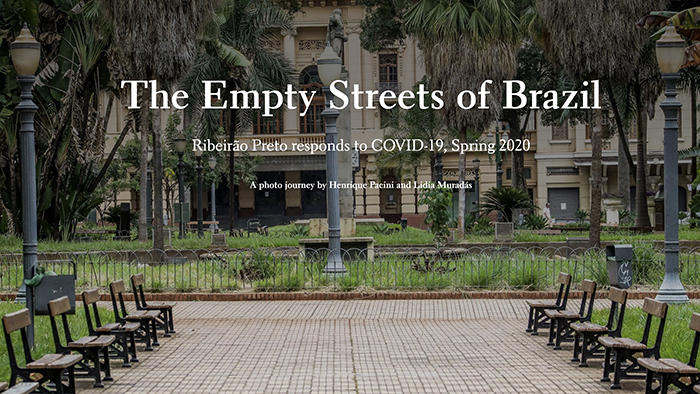A StoryMap photo journey by Weatherhead Center Fellow Henrique Pacini and Lidia Muradás takes viewers on a tour of a city in waiting as the COVID-19 pandemic unfolds through the streets of Ribeirão Preto, Brazil.
Once lauded for its public health response to the AIDS and Zika epidemics, Brazil is now struggling against an explosion of COVID-19 cases. It currently has the second highest number of cases, behind the US, and recorded the highest daily death rate in the world on May 27. In the third week of May, Brazil lost 6,500 citizens to COVID-19, a figure that is expected to double in a few weeks’ time. On May 26, President Trump banned entry into the US for anyone traveling from Brazil.
Brazil’s government has been reluctant to issue orders to curtail public gatherings, with President Jair Bolsonaro famously urging people to go out to restaurants and bars in early April. Many Brazilian state governors have mandated their own shutdown orders, putting them at odds with their president, who has urged businesses to stay open throughout the pandemic.
Weatherhead Center Fellow Henrique Pacini returned to his hometown, Ribeirão Preto, Brazil, in late March to shelter with his family. He arrived at a time when empty streets, shuttered storefronts, and mask-wearing were novel and haunting sights. Partnering with visual artist Lidia Muradás, the two photojournalists moved through the streets of their ghost-like city, capturing a moment in time—when the world was frozen, when people were hidden away indoors, bracing for the unknown.
VISIT STORYMAP: THE EMPTY STREETS OF BRAZIL
Henrique Pacini is a Fellow at the Weatherhead Scholars Program. He is also an economic affairs officer at the United Nations Conference on Trade and Development (UNCTAD).
Lidia Muradás is lead photojournalist of Revide magazine, and has worked in Ribeirão Preto for more than twenty years. Her work illustrates the human condition as it relates to environment, recycling, and social inequality in Brazil.

